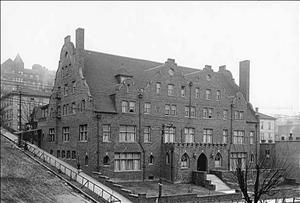On February 23, 1888, six Seattle civic leaders meet to organize an exclusive private gentleman's club, The Rainier Club. Formally incorporated on July 25, 1888, it becomes Seattle's preeminent private club, with first quarters in the James McNaught mansion on 4th Avenue in downtown Seattle.
Attendees at the first meeting were J. R. McDonald, president of the Seattle, Lake Shore & Eastern Railroad; John Leary, a prominent real estate developer and former Seattle mayor; Norman Kelly; R. C. Washburn, editor of the Seattle Post-Intelligencer; Bailey Gatzert, proprietor of Schwabacher's and former mayor; A. B. Stewart; and James McNaught, whose 4th Avenue mansion became the first clubhouse. Founding members also included lawyer Eugene Carr, Judge Thomas Burke, and William Allison Peters.
Gentlemen Only
In subsequent meetings, membership dues were set at $100, and bylaws were written, including that "No member shall invite ladies to the Club House without first obtaining permission from the trustees."
In 1904, the Rainier Club moved to a building on 820 4th Avenue in downtown Seattle designed by architect Kirtland Cutter (1860-1939), with a 1929 addition by architect Carl Gould. In its lavishly appointed historic building, the now non-discriminatory club remains (in 2001) a vibrant, thriving institution whose membership comprises civic leaders of both sexes and all races.
Networking, Victorian Style
A history of the club describes its early social significance as follows:
"...[I]t offered a place away from the office and public rooms of restaurants and hotels where political and business leaders could break fast or lunch, play cards (whist was the rage at the time) or billiards, and discuss new ideas, opportunities, or collaborations."In those Victorian times and the Edwardian period which would follow, it was customary for men and women to take much of their society apart from the opposite sex. In the evenings, the Rainier Club served as a private library and gaming room to which the most prominent men of Seattle could withdraw after dinner for cigars, brandy and conversation. This privilege, and the decorum it demands, would be jealously guarded throughout the Club's history" (Crowley, 23).

